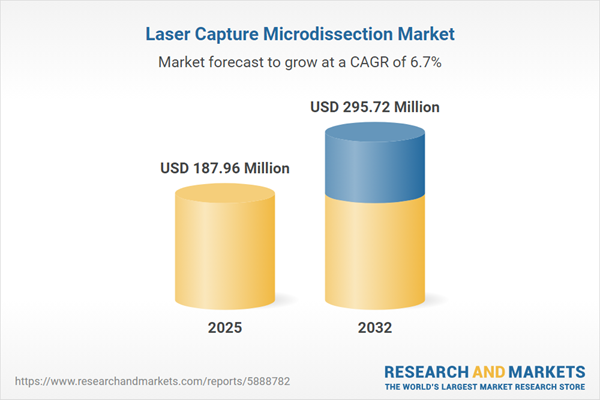Speak directly to the analyst to clarify any post sales queries you may have.
The laser capture microdissection market is evolving as a critical driver of precision in molecular research and diagnostics, with senior leaders increasingly prioritizing technology investments that strengthen analytical capabilities and operational resilience.
Market Snapshot: Laser Capture Microdissection Market Growth
Laser capture microdissection has advanced from a niche laboratory technique to a central pillar in high-resolution cell analysis. The market grew from USD 176.14 million in 2024 to USD 187.96 million in 2025, and is projected to expand at a CAGR of 6.69%, achieving USD 295.72 million by 2032.
Driven by technological innovation, applications across oncology, neuroscience, and plant biology are unlocking new research potential and supporting the development of targeted diagnostics.Scope & Segmentation of the Laser Capture Microdissection Market
- Product Segments: Accessories, Consumables, Software, Systems
- Application Areas: Biomarker Discovery, Cancer Research, Microbiology, Neuroscience, Plant Biology, Reproductive Biology
- Technology Types: Infrared Laser LCM, Laser Pressure Catapulting, Ultraviolet Laser LCM
- End User Categories: Academic Research Institutes, Contract Research Organizations, Diagnostic Laboratories, Pharmaceutical and Biotech Companies
- Tissue Preservation Methods: Formalin-Fixed Paraffin-Embedded, Fresh Frozen
- Regional Coverage: Americas (North America—including United States, Canada, Mexico; Latin America—including Brazil, Argentina, Chile, Colombia, Peru), Europe (United Kingdom, Germany, France, Russia, Italy, Spain, Netherlands, Sweden, Poland, Switzerland), Middle East (United Arab Emirates, Saudi Arabia, Qatar, Turkey, Israel), Africa (South Africa, Nigeria, Egypt, Kenya), Asia-Pacific (China, India, Japan, Australia, South Korea, Indonesia, Thailand, Malaysia, Singapore, Taiwan)
- Key Companies: Thermo Fisher Scientific Inc., Leica Microsystems GmbH, Carl Zeiss Microscopy GmbH, Miltenyi Biotec GmbH, MMI Molecular Machines & Industries GmbH, Olympus Corporation, Nikon Corporation, PerkinElmer, Inc.
Key Takeaways for Senior Decision-Makers
- The laser capture microdissection market is integral to advancing omics research, allowing for high-precision cell isolation and downstream molecular analysis across diverse scientific fields.
- Platform integration—combining advanced lasers, imaging modules, and automated software—has streamlined sample handling, improved reproducibility, and minimized operator variability for users in diagnostics and pharma.
- Researchers leverage these systems for complex tasks such as biomarker identification, enhancing the rigor of studies in oncology, neuroscience, and microbial ecology.
- End user needs differ: academic institutes prioritize flexibility, while contract research and clinical labs increasingly demand scalability and workflow reliability in their instrumentation choices.
- Regional adoption trends are shaped by funding landscapes, regulatory frameworks, and strategic partnerships, resulting in differentiated growth trajectories across North America, Europe, Asia-Pacific, and emerging regions in Latin America, the Middle East, and Africa.
- Key industry players drive competition and service innovation through collaborations that span instrumentation, consumables, and analytical software.
Impact of Tariff Measures on Supply Chain Dynamics
The introduction of updated U.S. tariffs on laboratory equipment in 2025 increased procurement complexity and operating costs for stakeholders reliant on imported instrumentation, consumables, and software. Distributors and end users responded by adjusting supplier strategies, renegotiating contracts, and exploring regional alternatives to maintain continuity and mitigate cost increases. Manufacturers reassessed sourcing and inventory practices, while multi-year service agreements gained favor as a means of stabilizing research budgets during tariff volatility.
Methodology & Data Sources
This report employs a dual-phase methodology encompassing comprehensive desk research and targeted primary interviews with market stakeholders. Sources span peer-reviewed journals, regulatory documents, industry reports, and patent filings. Structured interviews with key opinion leaders and technology providers enrich quantitative analysis, ensuring the study offers both depth and practical relevance.
Why This Report Matters for Strategic Planning
- Enables executives to benchmark evolving technology standards, user requirements, and vendor strategies for future-proof capital investments.
- Equips procurement and operational leaders with insights on navigating supply disruptions and optimizing supplier relationships in response to regulatory or economic shifts.
- Supports informed market entry and expansion initiatives by clarifying regional adoption patterns and emerging partnership opportunities.
Conclusion
The laser capture microdissection market is defined by its capacity to advance research accuracy and support the next wave of diagnostic solutions. Strategic partnerships, resilient sourcing, and continued technology integration will position stakeholders to capture growth and scientific impact in this dynamic landscape.
Additional Product Information:
- Purchase of this report includes 1 year online access with quarterly updates.
- This report can be updated on request. Please contact our Customer Experience team using the Ask a Question widget on our website.
Table of Contents
3. Executive Summary
4. Market Overview
7. Cumulative Impact of Artificial Intelligence 2025
Companies Mentioned
The companies profiled in this Laser Capture Microdissection market report include:- Thermo Fisher Scientific Inc.
- Leica Microsystems GmbH
- Carl Zeiss Microscopy GmbH
- Miltenyi Biotec GmbH
- MMI Molecular Machines & Industries GmbH
- Olympus Corporation
- Nikon Corporation
- PerkinElmer, Inc.
Table Information
| Report Attribute | Details |
|---|---|
| No. of Pages | 197 |
| Published | October 2025 |
| Forecast Period | 2025 - 2032 |
| Estimated Market Value ( USD | $ 187.96 Million |
| Forecasted Market Value ( USD | $ 295.72 Million |
| Compound Annual Growth Rate | 6.6% |
| Regions Covered | Global |
| No. of Companies Mentioned | 9 |









